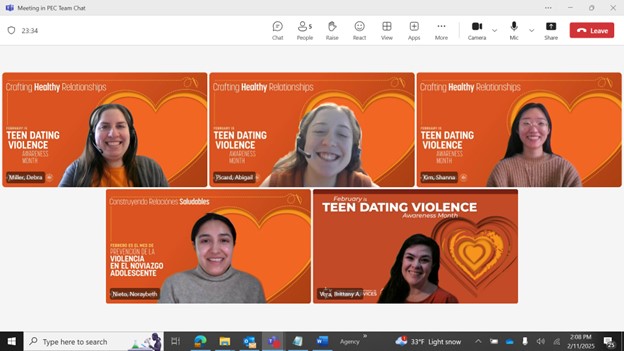
(Posted 2025 July)
It’s All in a Name: DSVS’ Prevention, Education, and Coordination Team Is the Missing Link
Two years ago, Domestic and Sexual Violence Services’ Countywide Coordination Team evolved into the Prevention, Education, and Coordination (PEC) team to strengthen the response to domestic violence, sexual violence, human trafficking, and stalking. Recently, Volunteer Voices sat down with PEC Team Program Manager Stacy Ziebell to talk about why this change was necessary and how it’s going as it approaches its second anniversary. This is an excerpt of that conversation.
Volunteer Voices: What does PEC do? What is its role in DSVS?
Stacy Ziebell: The name says it all: prevention, education, and coordination. This team really focuses on prevention programming in the community. Education--both for the community, for allied professionals, as well internally for staff and volunteers. Community engagement in various ways—from tabling to teen events, from training to technical assistance, where we are available to further develop capacity as well as resources and support on building policies, procedures, and processes. Connecting people to resources. And finally, for the coordination part, that is really about strengthening and further enhancing the coordinated community response to sexual violence, domestic violence, human trafficking, and stalking.
No one individual, no one organization, no one agency or division can address these issues alone. We have to work collaboratively to address gaps and achieve our goals.
We bring folks together to identify and address systems gaps and improve the overall response to sexual violence, domestic violence, human trafficking, and stalking.
We also hold grants working with teens and children. We do policy work analyzing the legislation coming through the Virginia general assembly. And we’re now super excited to include volunteer management!
We serve the community, and we also connect across the whole division. We are a resource to all of DSVS.
How is PECT different from Countywide Coordination, the previous team?
We had found there was a lot of overlap and duplication of work. In the interest of streamlining and helping with that coordination effort, we decided to bring it together under one roof. We did the research for months--including a strategic planning process within our team to develop our mission and vision--to determine how we were going to work and how we were going to work with the community. Training, education, and community engagement are all pieces of the puzzle, and now we are able to be more impactful. One hundred percent this was a wonderful move, and it just makes a lot of sense.
What are the various initiatives that live under PEC?
Volunteer management, HYPE, PILAS, our Teen Advocates Program, the Resilient Kids Thriving Families grant, Community Conversations, SV and DV Tier 1s, Step Up 4 Kids, the Sexual Assault Response Team (SART), the Domestic Violence Fatality Review Team, the Council to End Domestic Violence (CEDV), the DV Network, Prevention and Education Committee, Human Trafficking Group—and various subgroups and committees that live under these initiatives. PEC also holds legislative and policy review, training/professional development, technical assistance, grant and project management, and community engagement.
What does PEC look like in action?
A blur, because we do so much. But I don’t mean that in a negative way. Let’s call it a Matisse. We juggle so many initiatives and programs, but if you think of them as colors, they come together beautifully on the canvas.
What’s your role?
I am the program manager, so I have oversight over the various streams of work. I’m so lucky to get to work with the best team in the world.
What do you want to implement but haven’t yet?
I’d love to have more community conversations and move that initiative into new communities. It’s really wonderful grassroots work. It’s prevention programming at its best. It’s a community-driven process to support and facilitate individuals and groups within the community to identify challenges and work to drive change, shift attitudes and norms, resulting in more safety for victims and survivors, their families, and the community, and more accountability for those who cause harm.
[Editor’s note: This program currently exists in the Culmore Community.] I would love to expand it to wherever there’s need—and the communities ask for it.
I would like to see barriers reduced for the LGBTQ+ community in accessing services and the readiness of services to serve that community so Fairfax can really be a safe and welcoming space for that community.
I want to build our capacity as top-notch trainers.
What’s something we should know about PEC but don’t?
One serious thing: We are not just an external resource. We are also an internal source for DSVS for resources and consultation, and we provide advice or input on presentations and facilitation of meetings and trainings.
One fun thing: PEC has the best snacks and fidgets!


